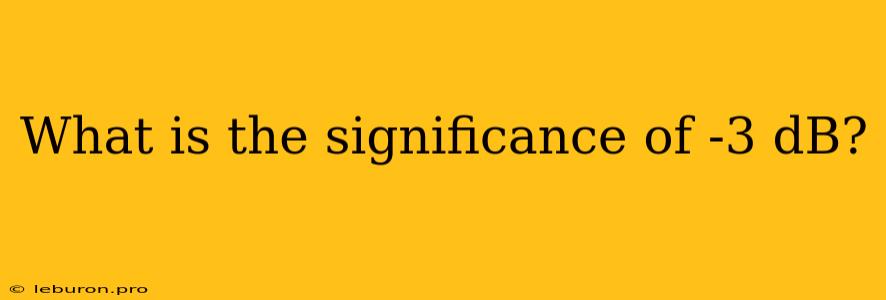The concept of -3 dB, often referred to as the "half-power point" or "3 dB down point," holds significant importance in various fields, particularly in audio engineering, electronics, and signal processing. It represents a specific point on a signal's amplitude or power spectrum where the signal's strength is reduced by half, or equivalently, by 3 decibels (dB). This seemingly simple concept plays a crucial role in defining critical parameters and characteristics of systems and signals, influencing our understanding of signal attenuation, bandwidth, and overall performance.
Understanding Decibels (dB)
Before delving into the significance of -3 dB, it's essential to grasp the concept of decibels (dB). Decibels are a logarithmic unit used to express the ratio of two values, typically power or amplitude. The logarithmic nature of dB allows for a more manageable representation of a wide range of values, often encountered in audio and electrical systems.
A change of 3 dB corresponds to a doubling or halving of power. This means that an increase of 3 dB represents a doubling of power, while a decrease of 3 dB signifies a halving of power. It's important to note that a 3 dB change in amplitude corresponds to a 6 dB change in power.
-3 dB Point: The Half-Power Point
The -3 dB point, also known as the half-power point, represents the frequency or point on a spectrum where the signal's power is reduced by half. This point is crucial in various contexts, including:
1. Bandwidth Determination
In audio engineering, the -3 dB point is often used to define a system's bandwidth. Bandwidth refers to the range of frequencies that a system can effectively transmit or receive without significant attenuation. The -3 dB point marks the frequency at which the signal's power has dropped by half. This point is commonly used to define the cutoff frequency of filters, amplifiers, and other audio systems.
2. Signal Attenuation and Filtering
The -3 dB point helps characterize signal attenuation and filtering in electronic systems. When a signal passes through a filter or amplifier, its strength can be reduced due to the filtering process. The -3 dB point indicates the frequency at which the signal's power is reduced by half. This point is often used to specify the filter's cutoff frequency or the amplifier's gain reduction.
3. Understanding System Performance
In various systems, such as amplifiers, speakers, and antennas, the -3 dB point provides insights into their performance. For instance, an amplifier's power output might be specified at the -3 dB point, indicating the frequency at which its output power is halved. Similarly, a speaker's frequency response might be measured up to the -3 dB point, indicating the frequency range where the speaker delivers its full power.
Importance in Audio Engineering
In audio engineering, the -3 dB point plays a crucial role in several aspects:
1. Equalization and Mixing
Audio engineers utilize the -3 dB point in equalization and mixing to adjust the frequency response of audio signals. By boosting or cutting specific frequencies at the -3 dB point, engineers can emphasize or reduce certain frequencies in a signal, shaping the overall sound.
2. Crossover Design
Crossover networks, which separate audio signals into different frequency ranges for different speakers, rely on the -3 dB point. They are typically designed to ensure a smooth transition between different speaker drivers, minimizing unwanted phase shifts and ensuring a balanced sound.
3. Microphone Sensitivity
Microphones have a specific sensitivity rating, often expressed in dB. This rating indicates the microphone's output level for a given sound pressure level. The -3 dB point can be used to understand the microphone's response at different frequencies, indicating its sensitivity at specific frequencies.
Conclusion
The -3 dB point, the frequency or point on a spectrum where the signal's power is reduced by half, holds significant importance in various fields, particularly in audio engineering, electronics, and signal processing. Understanding this concept enables us to define critical parameters such as bandwidth, signal attenuation, and filter cutoff frequencies. Its application extends to various aspects of audio engineering, including equalization, mixing, crossover design, and microphone sensitivity. By grasping the -3 dB point, we gain a deeper understanding of the nuances of signal processing and system performance, ultimately contributing to a more accurate and informed approach to audio engineering and other relevant disciplines.
